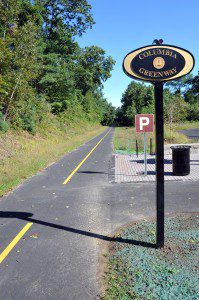
The city is preparing to advertise the next segment of rail trail work in December and that the city has been “assigned” a $2 million grant for construction of the trail to the area of East Silver Street, extending the rail trail another 5,025 feet. (Photo by chief photographer Frederick Gore)
WESTFIELD – The Conservation Commission voted Tuesday to continue the public hearing on the next segment of the Columbia Greenway rail trail to allow time for board members to inspect the Tin Bridge area of the trail where it crosses over Little River.
Details of the project were presented by John J. Bechard, P.E. and Douglas Vigneau, senior project manager, of Vanasse Hangen Brustlin, Inc. (VHB), the engineering firm hired by the city to design the rail trail.
Bechard said the city is preparing to advertise the next segment of rail trail work in December and that the city has been “assigned” a $2 milli0on grant for construction of the trail to the area of East Silver Street, extending the rail trail another 5,025 feet.
“VHB has been working with the city for a number of years to convert the former railroad to the Columbia Greenway,” Bechard said during the public hearing before the Conservation Commission, which will approve an order of conditions to mitigate environmental impact of the project on the Little River resource area.
Bechard said the impact would be minimal since the railroad track already exists and the Columbia Greenway will be constructed within the railroad right of way.
“The bridge over Little River will be cleaned and repainted with installation of a new concrete deck and rail system on the bridge for safety,” Bechard said. “There will also be two (overlook) areas created on either side of the bridge. It’s a pretty breath-taking view.”
Vigneau said the environmental impact is less intrusive than the first section of the trail from the Southwick town line to about 500 feet short of Tin Bridge. The first section of the trail, which includes a parking area accessed through the Shaker Farms Country Club, crossed through several resource or environmentally sensitive areas.
“This is more straightforward than that Shaker Farms area work,” Vigneau said. “There is about 50,000 square feet of riverfront area. This is a redevelopment project in a degraded riverfront area, so there will be cleanup.”
Conservation Chairman Dr. David Doe said that under the Department of Environmental Protection (DEP) regulations there has to be improvement to the riverfront resource area. That improvement can be done through a variety of options including additional plantings, removal of invasive plant species, and soil stabilization.
Bechard and Vigneau said construction of the trail would include cutting back vegetation, much of which is invasive species, loaming and planting grass along the shoulders of the trail that will help stabilize the edges of the trail.
“This phase is more elevated, where the rail bed is above everything,” Vigneau said.
The trail will be extended from the south side of Tine Bridge to the Coleman Avenue area where an access will be installed.
Bechard said the project is time sensitive because of the $2 million state grant. The estimated cost of the next segment is about $2,225,000.
“The time frame is that we hope to complete construction by next summer,” Bechard said. “There is a tight timeline because the grant has an expiration date (of June 30, 2013).”

